Wool Manufacturing at Winooski Falls
By Matthew Goguen
Section One: The Old Mill (c.1835 – 1957)
The mill buildings located on West Canal Street in Winooski, Vermont have undergone a long evolution from bustling wool production to modern apartments with numerous amenities. Through explosions of success, harsh depressions, cataclysmic flooding, and their eventual closing in 1956, these mill buildings have contributed to the character of Winooski. As they stand today, these mill buildings still contribute to Winooski and serve as an example of how re-use of historic structures can maintain a sense of place during a new downtown revitalization.
The earliest formation of a mill company in what is now the West Canal Street area in Winooski has its origins in 1812. It was here that a small factory engaged in the creation of broadcloth was erected. Other mills around the Winooski Falls area were built close to the river to take as much advantage of its head and flow as possible. However, in 1830, a devastating flood demolished many of the mills under the ownership of local business owners Amos Weeks, Moses Catlin and Charles Burnham.1
Following the devastating flood of 1830, a charter was initiated in 1835 for the formation of a new mill company. This company, through various financial gains and woes would eventually be absolved by the American Woolen Company in 1901, but began earnestly under the name of the Burlington Mill Company.
The first building erected by the Burlington Mill Company, later known as Mill No. 1, was a six-story brick building that stood 330 feet long and featured a bell tower. It was built circa 1835.2 Within the walls of this particular mill, uniform cloth, kerseys, cassimeres, ladies’ dress goods and billiard cloths.3 Though the building is cited as being six stories tall, it was likely that it was actually only four stories of production space. The basement story included the turbines, which powered the mill equipment above. The highest story of the building was the top of the bell tower. In 1861, when the company was incorporated as the Burlington Woolen Corporation, this building was the primary site of production. The incorporation of the company was prompted by lack of financial returns for the original business’s stakeholders.
In 1861, an investment team consisting of businessmen from Massachusetts including Joseph Sawyer and Thomas Patterson of Boston and Frederick Kennedy purchased the business for $200,000 and began great expansion.4
The materials produced in the Mill No. 1 building (also known as The Old Mill, as it was the first enduring structure from previous incarnations of the business) were of great significance to the American marketplace. The uniform cloth that was produced here served many purposes including military, particularly in the Civil War, as well as standard material for police officers. Kerseys were ribbed woolen cloth that was typically found in workers’ clothing, as well as winter coats. Cassimeres were wool fabrics that were woven very smooth and used to make mens’ suits. The mill also produced fine billiard cloth as well as womens’ cloakings and dress goods. The output of this one mill serviced the needs of men, women, wealthy and working class all from under one roof. Unfortunately, the Old Mill building burned to the ground in 1957, thus ending one of the most successful chapters of the manufacturing history of Winooski.

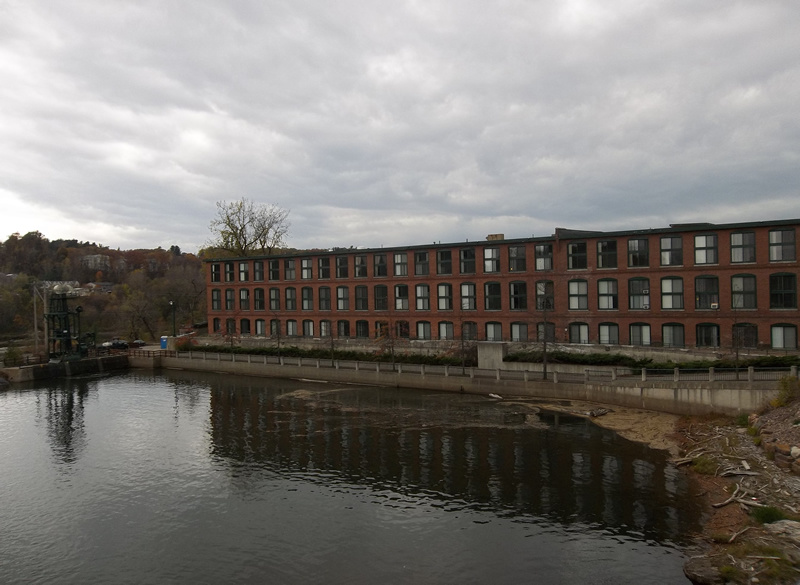
Section Two: The Colchester-Merino Mill (1880 – present)
At a time of prosperity for the Burlington Woolen Company, the Colchester-Merino Mill was erected in 1880. Numerous buildings would be added and swallowed by the Colchester-Merino Mill over time but its principal features are unique in its own right. The Colchester-Merino Mill, now known as simply, The Woolen Mill, stands three stories tall with dimensions of 99 feet wide by 235 feet long.5 As the name implies, merino wool was primarily processed in this mill. The wool was spun into a soft yarn and used for other clothing purposes.
Within the same general footprint for the Colchester-Merino Mill was the Winooski-Worsted Mill. In 1901, after the Burlington Woolen Company was purchased by the much larger American Woolen Company, construction began in earnest to unite the two structures. Renovation work and general maintenance also took place as part of a large sum of investments by the new owners.6
The Winnoski-Worsted Mill also housed specific processing for worsted wool. Compared to merino, worsted is a product that is very compact and used for firm fabrics and goods like gloves, blankets and some carpet material. It is estimated that in 1902, the Winooski-Worsted Mill became part of the overall structure known as the Colchester-Merino Mill.
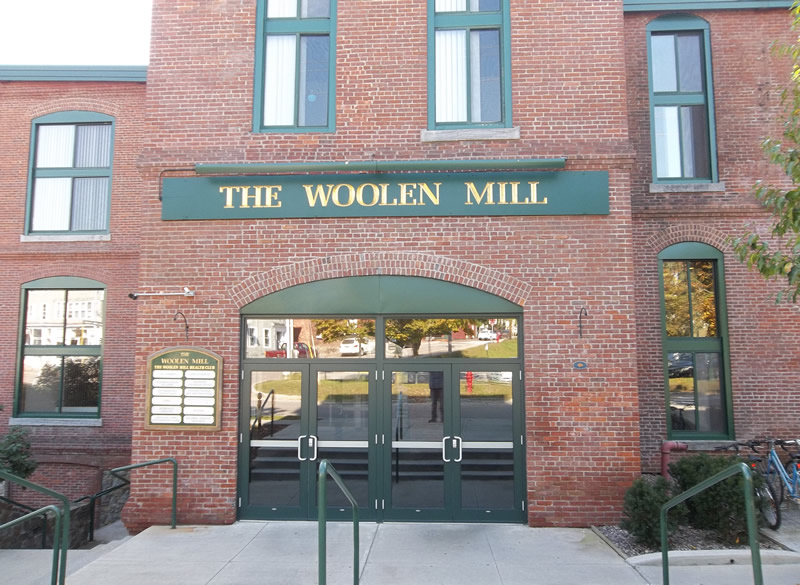
Section Three: The Carbonizing Plant (1909 – present)
An essential part of the wool milling process took place behind these walls on West Canal Street. The act of “carbonizing” raw wool components prior to its spinning into yarn and goods was a practice to ensure a consistent, uniform material.
Raw wool was cleaned and scoured of natural nuisances like burrs and grass. For more intense cleaning, chemical solutions were used to burn away the imperfections.
In the Carbonizing Plant’s registration form for the National Register of Historic Places, the cleaning process was described as using bowls or troughs with different chemical solutions like sulfuric acid or aluminum chloride. The incoming wool would be immersed in the chemical solutions before being rolled, dried and inspected for imperfections.7
It is likely that in previous incarnations of the woolen mills at this location that some kind of processing procedure was in place for the cleaning of wool. The addition of this building in 1909 by the American Woolen Company suggests that a more streamlined plan of raw wool to finished product or an influx in production led to its construction.
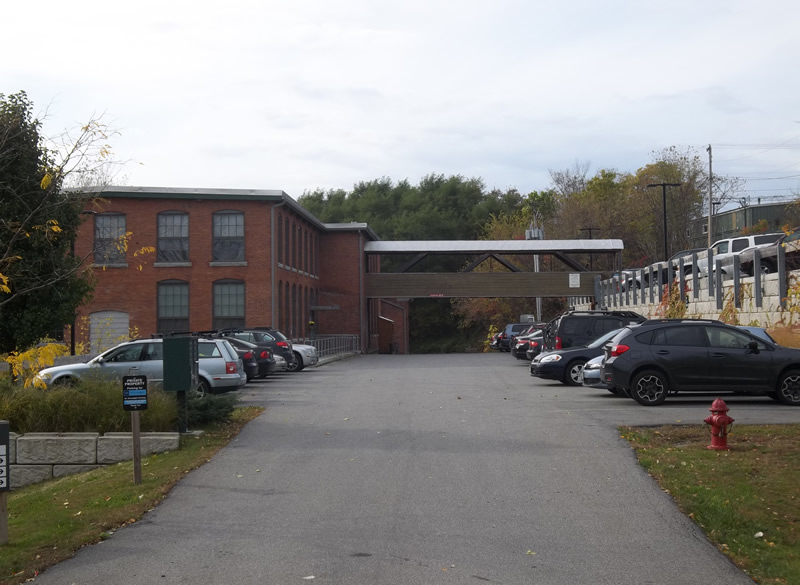
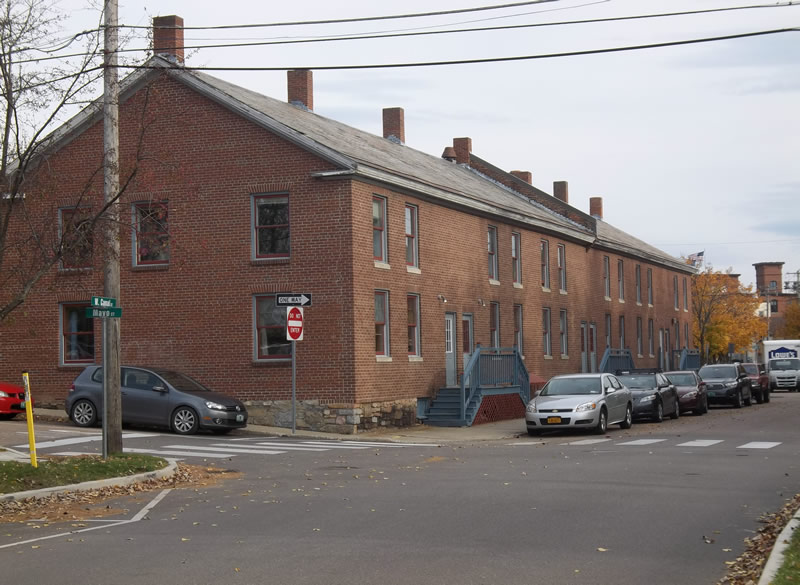
Section Four: Greek Revival Rowhouse (c. 1840s - present)
An enticing perk of many burgeoning mill businesses was the availability of housing or dormitories for their workers. For immigrant and domestic workers alike, these housing units provided a smooth transition to a new job. Typically, the units were located just mere footsteps from a mill and close to the trappings of urban life. The mill towns of Fitchburg, Lowell and Lawrence, Massachusetts used similar enticements for its workers as did Winooski.
The boarding house in this picture was constructed in the 1840s and is believed to have initially housed young girls. Raymond Roy, a former superintendent at the Chace Mill, another American Woolen Company property across the Winooski River Bridge, described living conditions at the rowhouse by saying, “They had a housemother, and they were very strict. There was a curfew. The conditions were just as good anywhere. They had good food…”8
But as the working culture of the mills evolved, so too did the use of this boarding house. In the early twentieth century, the mills hired more and more married couples in addition to young women. The married couples built houses in the city if they could afford to, or in some cases rented from the mill company. The boarding house in this picture eventually became a grocery store and bar before its present use today as a Chinese restaurant and private offices. As it stands, the building’s historical integrity is well preserved.
Section Five: The Flood of 1927 and its Lasting Effects
Following the purchase of the Burlington Woolen Company by the American Woolen Company, the mills at Winooski Falls were a thriving institution. During World War I, wool was being produced for military uniforms and overcoats. But the devastating flood of 1927 was seemingly the death knell for the company.9
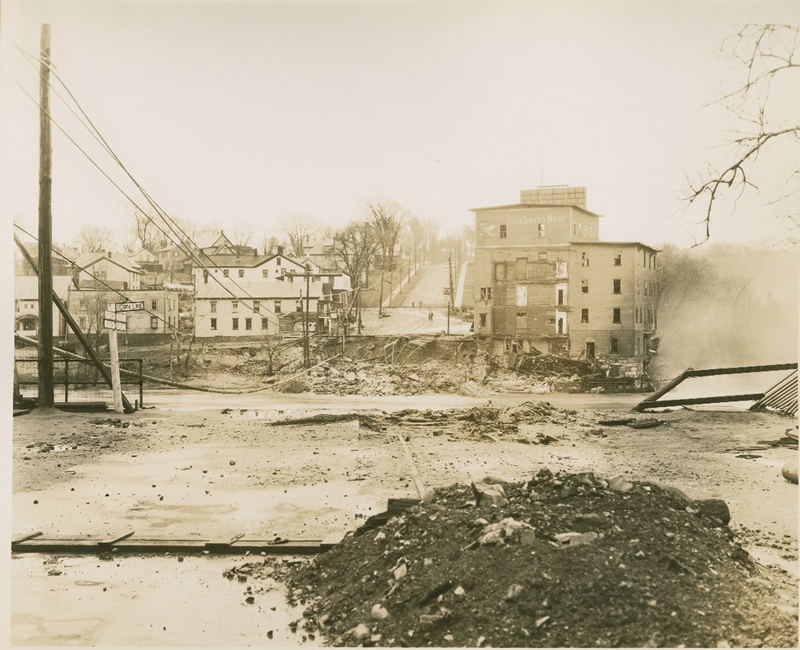
In November of 1927, after three continuous days of rain, the Winooski River flooded. One of the hardest hit mill buildings was the Champlain Mill, then only fifteen years old adjacent on the other side of the river from the Colchester-Merino Mill. Though work would eventually begin again, things were never quite the same. World War II brought a steady supply of work, again, the manufacturing of military uniforms and their overcoats was in high demand. However, following the war the demand for woolen products became less and less with each passing year. The development of cheaper, synthetic fibers in the marketplace also contributed to the overall decline in demand and production. The mills officially ceased production in 1956. After a few years as a retail outlet, the Colchester-Merino Mill fell into ownership of an out of state company who planned to turn the space into apartments. Today, the building still stands and is a combination of commercial space and apartments.

Notes
2. Industries and Wealth of the Principal Points in Vermont, (American Publishing and Engraving, 1891).
3. Ibid.
4.Ibid.
5. Ibid.
6. "Woolen Mills Sold," Burlington Free Press, December 19th, 1901.
8 Marjorie Stinchcombe, "From Boardinghouse for Millhands to Restaurant," Burlington Free Press, July 25th, 1996 1996.
7 Liisa Reismann, "Winooski Falls Mill Historic District - Boundary Increase - National Register of Historic Places Inventory Registration Form," ed. United States Department of the Interior (2009)
9 Hugh A. Henry and Roger Brevoort, "Winooski Falls Mill Historic District - National Register of Historic Places Inventory Nomination Form," ed. United States Department of the Interior (1978).